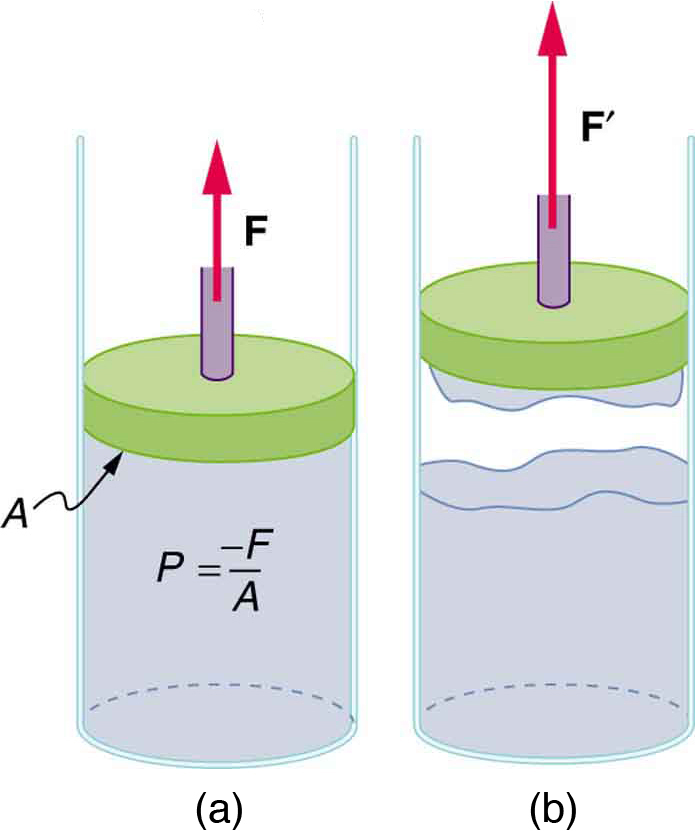| << Chapter < Page | Chapter >> Page > |
How does sap get to the tops of tall trees? (Recall that a column of water can only rise to a height of 10 m when there is a vacuum at the top—see [link] .) The question has not been completely resolved, but it appears that it is pulled up like a chain held together by cohesive forces. As each molecule of sap enters a leaf and evaporates (a process called transpiration), the entire chain is pulled up a notch. So a negative pressure created by water evaporation must be present to pull the sap up through the xylem vessels. In most situations, fluids can push but can exert only negligible pull , because the cohesive forces seem to be too small to hold the molecules tightly together. But in this case, the cohesive force of water molecules provides a very strong pull. [link] shows one device for studying negative pressure. Some experiments have demonstrated that negative pressures sufficient to pull sap to the tops of the tallest trees can be achieved.

The density of oil is less than that of water, yet a loaded oil tanker sits lower in the water than an empty one. Why?
Is surface tension due to cohesive or adhesive forces, or both?
Is capillary action due to cohesive or adhesive forces, or both?
Birds such as ducks, geese, and swans have greater densities than water, yet they are able to sit on its surface. Explain this ability, noting that water does not wet their feathers and that they cannot sit on soapy water.
Water beads up on an oily sunbather, but not on her neighbor, whose skin is not oiled. Explain in terms of cohesive and adhesive forces.
Could capillary action be used to move fluids in a “weightless” environment, such as in an orbiting space probe?
What effect does capillary action have on the reading of a manometer with uniform diameter? Explain your answer.
Pressure between the inside chest wall and the outside of the lungs normally remains negative. Explain how pressure inside the lungs can become positive (to cause exhalation) without muscle action.
What is the pressure inside an alveolus having a radius of if the surface tension of the fluid-lined wall is the same as for soapy water? You may assume the pressure is the same as that created by a spherical bubble.
(a) The pressure inside an alveolus with a -m radius is , due to its fluid-lined walls. Assuming the alveolus acts like a spherical bubble, what is the surface tension of the fluid? (b) Identify the likely fluid. (You may need to extrapolate between values in [link] .)
What is the gauge pressure in millimeters of mercury inside a soap bubble 0.100 m in diameter?
Calculate the force on the slide wire in [link] if it is 3.50 cm long and the fluid is ethyl alcohol.
[link] (a) shows the effect of tube radius on the height to which capillary action can raise a fluid. (a) Calculate the height for water in a glass tube with a radius of 0.900 cm—a rather large tube like the one on the left. (b) What is the radius of the glass tube on the right if it raises water to 4.00 cm?
(a)
(b)
We stated in [link] that a xylem tube is of radius . Verify that such a tube raises sap less than a meter by finding for it, making the same assumptions that sap's density is , its contact angle is zero, and its surface tension is the same as that of water at .
What fluid is in the device shown in [link] if the force is and the length of the wire is 2.50 cm? Calculate the surface tension and find a likely match from [link] .
Based on the values in table, the fluid is probably glycerin.
If the gauge pressure inside a rubber balloon with a 10.0-cm radius is 1.50 cm of water, what is the effective surface tension of the balloon?
Calculate the gauge pressures inside 2.00-cm-radius bubbles of water, alcohol, and soapy water. Which liquid forms the most stable bubbles, neglecting any effects of evaporation?
Alcohol forms the most stable bubble, since the absolute pressure inside is closest to atmospheric pressure.
Suppose water is raised by capillary action to a height of 5.00 cm in a glass tube. (a) To what height will it be raised in a paraffin tube of the same radius? (b) In a silver tube of the same radius?
Calculate the contact angle for olive oil if capillary action raises it to a height of 7.07 cm in a glass tube with a radius of 0.100 mm. Is this value consistent with that for most organic liquids?
This is near the value of for most organic liquids.
When two soap bubbles touch, the larger is inflated by the smaller until they form a single bubble. (a) What is the gauge pressure inside a soap bubble with a 1.50-cm radius? (b) Inside a 4.00-cm-radius soap bubble? (c) Inside the single bubble they form if no air is lost when they touch?
Calculate the ratio of the heights to which water and mercury are raised by capillary action in the same glass tube.
The ratio is negative because water is raised whereas mercury is lowered.
What is the ratio of heights to which ethyl alcohol and water are raised by capillary action in the same glass tube?

Notification Switch
Would you like to follow the 'College physics for ap® courses' conversation and receive update notifications?